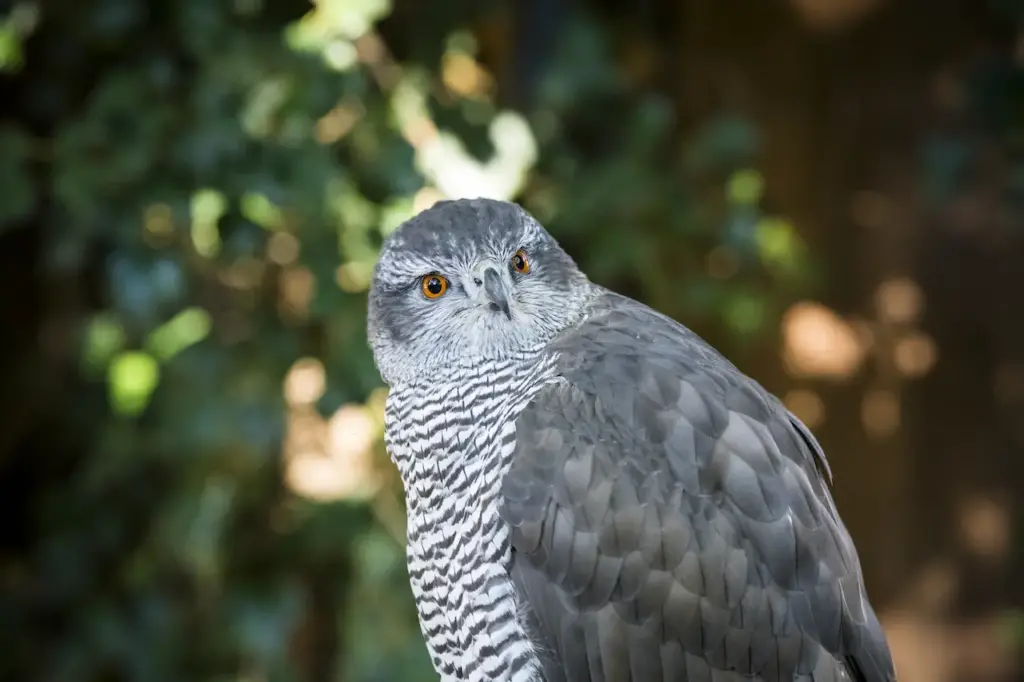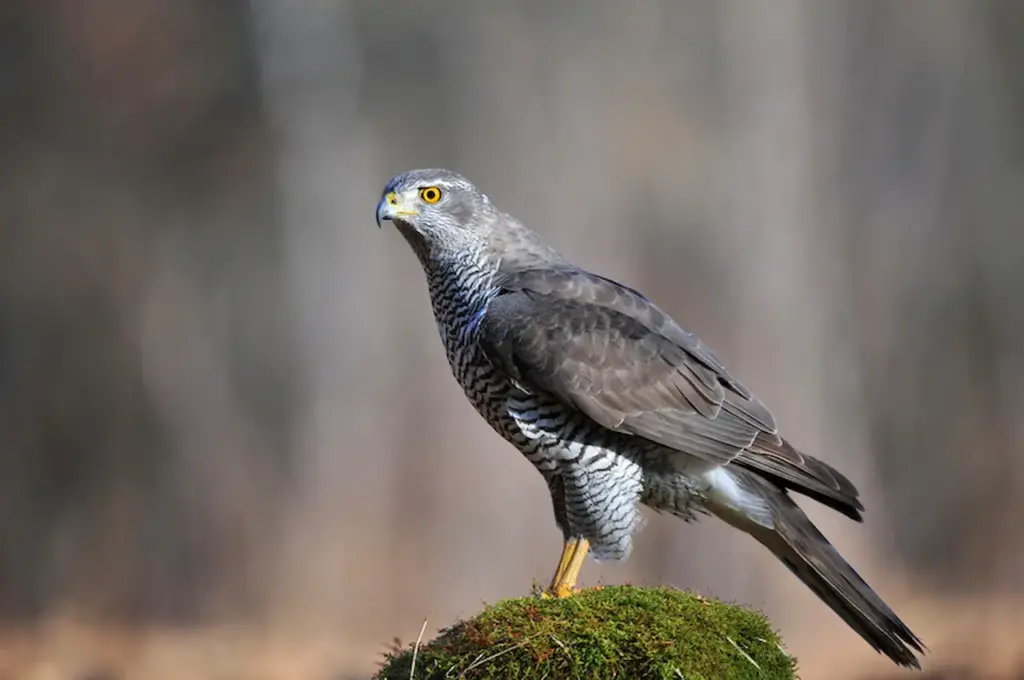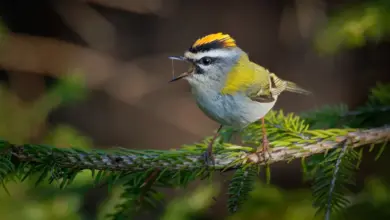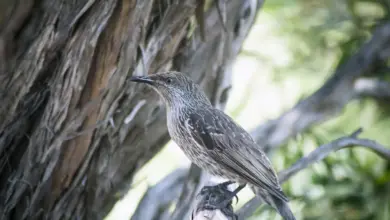The Goshawks (Accipiter gentilis; from Old English Language: góshafuc ‘goose-hawk’) is a medium-large bird of prey in the family Accipitridae, which also includes other diurnal raptors, such as eagles, buzzards and harriers.

It is a widespread species that inhabits the temperate parts of the northern hemisphere. In North America, it is called the Northern Goshawk. It is mainly resident, but birds from colder regions of north Asia and Canada migrate south for the winter.
The name “Goshawk” is derived from “goose hawk” and may refer to this bird’s barred plumage as well as its ability to take large prey.
Distribution / Range:
It is a geographically widespread species and inhabits the temperate parts of the northern hemisphere. In North America, it is called the Northern Goshawk. It is mainly resident, but birds from colder regions of north Asia and Canada migrate south for the winter.
In Britain the Goshawk became extinct in the 19th century because of specimen collectors and persecution by gamekeepers, but in recent years it has come back by immigration from Europe, escaped falconry birds, and deliberate releases.
In Eurasia, the male is confusable with a female Sparrowhawk, but is larger, much bulkier and has relatively longer wings. In spring, he has a spectacular roller-coaster display, and this is the best time to see this secretive forest bird.
Description:
The Goshawk is the largest member of the genus Accipiter. It is a raptor with short, broad wings and a long tail, both adaptations to manoeuvring through trees in the forests it lives and nests in.
The male is blue-grey above and barred grey below, 49-56 cm long with a 93-105 cm (37″-41″) wingspan.
The female is larger, averaging 58-64 cm in length with a 108–127 cm (43–50 in) wingspan, slate-grey above and grey below.
Males of the smaller races can weigh as little as 630 grams (22 oz), whereas females of the larger races can weigh as much as 2 kg (4.4 lb).
The juvenile is brown above and barred brown below.
The flight is a characteristic “slow flap – slow flap – straight glide”.

Identification:
In Eurasia, the male is sometimes confused with a female Sparrowhawk, but is larger, much bulkier and has relatively longer wings.
In North America, juveniles are sometimes confused with the smaller Sharp-shinned Hawks and Cooper’s Hawks, but the size again is a distinctive feature of the Northern Goshawk.
Behavior
In the spring breeding season, the Goshawk has a spectacular “rollercoaster” display, and this is the best time to see this secretive forest bird. At this time, the surprisingly gull-like call of this bird is sometimes heard.
Adults return to their nesting territories by March or April and begin laying eggs in April or May. These territories almost always include tracts of large, mature trees that the parents will nest in.
The clutch size is usually 2 to 4, but anywhere from 1 to 5 eggs may be laid. The eggs average 59 mm × 45 mm (2.3 in × 1.8 in) and weigh about 60 g (2.1 oz). The incubation period can range from 28 to 38 days.
The young leave the nest after about 35 days and start trying to fly another 10 days later. The young may remain in their parents’ territory for up to a year of age. Adults defend their territories fiercely from everything, including passing humans, so even the eggs have few predators. Birds of any age may be attacked, rarely, by Bubo owls and large Buteo hawks, but these often cede to or are themselves killed by the aggressive Goshawk.
Feeding / Hunting:
This species hunts birds and mammals in woodland, relying on its speed of flight through the dense forest as it flies from a perch or hedge-hops to catch its prey unaware. They are usually opportunistic predators, as are most birds of prey.
The most important prey species are rodents and birds, especially the Ruffed Grouse in North America, pigeons and doves, and passerines (mostly starlings and crows). Waterfowl up to the size of the Mallard are sometimes preyed on.
Prey is often smaller than the hunting hawk, but these birds will also rarely kill much larger animals, up to the size of snowshoe hares and jack rabbits.
Call / Song:
Its call is a fierce screech.
In Falconry
Goshawks are much used in falconry.
In falconry, “Finnish goshawks” (goshawks from Finland, or descended from goshawks brought from Finland) are prized because they are bigger and stronger than western European native goshawks.

Status
In United Kingdom and Ireland, the Goshawk became extinct in the 19th century because of specimen collectors and persecution by gamekeepers, but in recent years it has come back by immigration from Europe, escaped falconry birds, and deliberate releases. The Goshawk is now found in considerable numbers in Kielder Forest, Northumberland, which is the largest forest in Britain. The main threat to Goshawks internationally today is the clearing of forest habitat on which both they and their prey depend.
John James Audubon illustrates the Goshawk in Birds of America, Second Edition (published, London 1827-38) as Plate 141 where an adult and juvenile are accompanied by a Stanley Hawk. The compound image (made up from more than one original) was engraved and colored by Robert Havell’s London workshops.
The original watercolor by Audubon was purchased by the New York History Society where it remains. William Lewin illustrates the Goshawk under the title “Goss Hawk” as Plate 9 in volume 1 of his Birds of Great Britain and their Eggs published in London, 1789.
Trivia
- This species was first described by Linnaeus in his Systema naturae in 1758 under its current scientific name.
- The Goshawk appears on the flag of the Azores. The archipelago of the Azores, Portugal, takes its name from the Portuguese language word for Goshawk, (açor), because the explorers who discovered the archipelago thought the birds of prey they saw there were Goshawks; later it was found that these birds were kites or Common Buzzards (Buteo buteo rothschildi).





